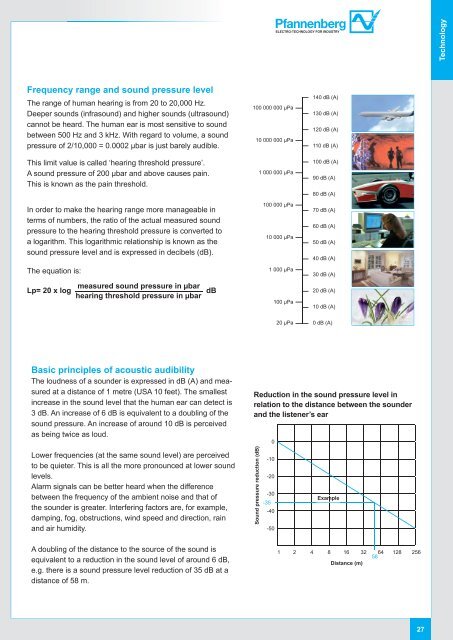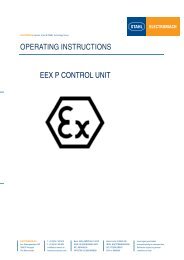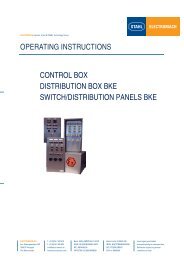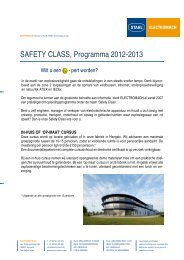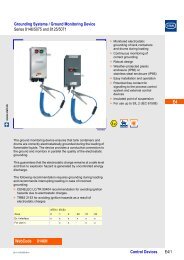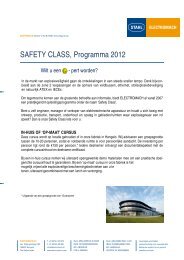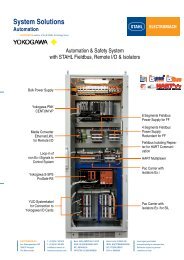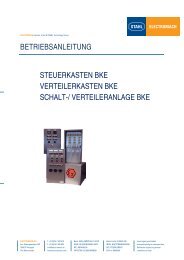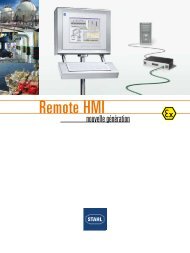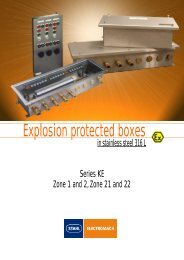Pfannenberg Catalogue
Pfannenberg Catalogue
Pfannenberg Catalogue
Create successful ePaper yourself
Turn your PDF publications into a flip-book with our unique Google optimized e-Paper software.
ELECTRO-TECHNOLOGY FOR INDUSTRY<br />
Technology<br />
Frequency range and sound pressure level<br />
The range of human hearing is from 20 to 20,000 Hz.<br />
Deeper sounds (infrasound) and higher sounds (ultrasound)<br />
cannot be heard. The human ear is most sensitive to sound<br />
between 500 Hz and 3 kHz. With regard to volume, a sound<br />
pressure of 2/10,000 = 0.0002 μbar is just barely audible.<br />
This limit value is called ‘hearing threshold pressure’.<br />
A sound pressure of 200 μbar and above causes pain.<br />
This is known as the pain threshold.<br />
In order to make the hearing range more manageable in<br />
terms of numbers, the ratio of the actual measured sound<br />
pressure to the hearing threshold pressure is converted to<br />
a logarithm. This logarithmic relationship is known as the<br />
sound pressure level and is expressed in decibels (dB).<br />
The equation is:<br />
Lp= 20 x log<br />
measured sound pressure in μbar dB<br />
hearing threshold pressure in μbar<br />
100 000 000 μPa<br />
10 000 000 μPa<br />
1 000 000 μPa<br />
100 000 μPa<br />
10 000 μPa<br />
1 000 μPa<br />
100 μPa<br />
140 dB (A)<br />
130 dB (A)<br />
120 dB (A)<br />
110 dB (A)<br />
100 dB (A)<br />
90 dB (A)<br />
80 dB (A)<br />
70 dB (A)<br />
60 dB (A)<br />
50 dB (A)<br />
40 dB (A)<br />
30 dB (A)<br />
20 dB (A)<br />
10 dB (A)<br />
20 μPa<br />
0 dB (A)<br />
Basic principles of acoustic audibility<br />
The loudness of a sounder is expressed in dB (A) and measured<br />
at a distance of 1 metre (USA 10 feet). The smallest<br />
increase in the sound level that the human ear can detect is<br />
3 dB. An increase of 6 dB is equivalent to a doubling of the<br />
sound pressure. An increase of around 10 dB is perceived<br />
as being twice as loud.<br />
Reduction in the sound pressure level in<br />
relation to the distance between the sounder<br />
and the listener’s ear<br />
0<br />
Lower frequencies (at the same sound level) are perceived<br />
to be quieter. This is all the more pronounced at lower sound<br />
levels.<br />
Alarm signals can be better heard when the difference<br />
between the frequency of the ambient noise and that of<br />
the sounder is greater. Interfering factors are, for example,<br />
damping, fog, obstructions, wind speed and direction, rain<br />
and air humidity.<br />
Sound pressure reduction (dB)<br />
-10<br />
-20<br />
-30<br />
-35<br />
-40<br />
-50<br />
Example<br />
A doubling of the distance to the source of the sound is<br />
equivalent to a reduction in the sound level of around 6 dB,<br />
e.g. there is a sound pressure level reduction of 35 dB at a<br />
distance of 58 m.<br />
1 2 4 8 16 32 64 128 256<br />
58<br />
Distance (m)<br />
27


